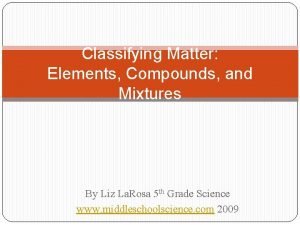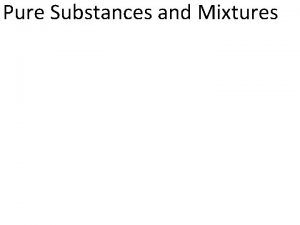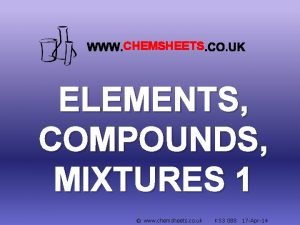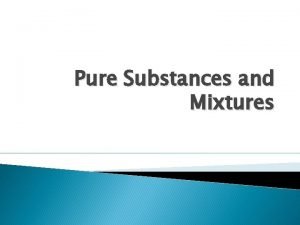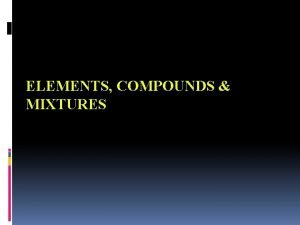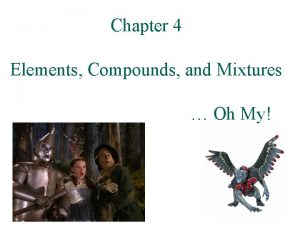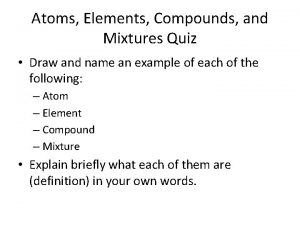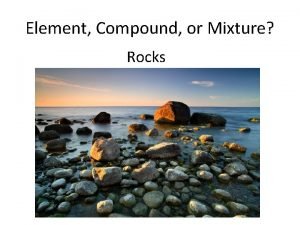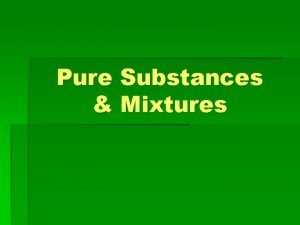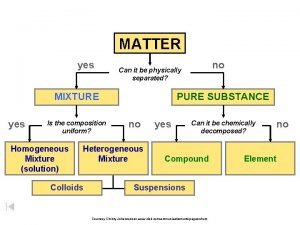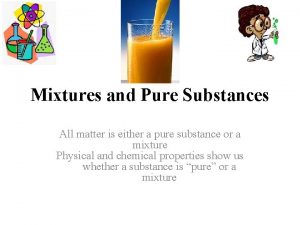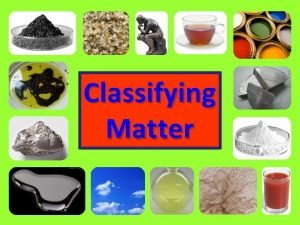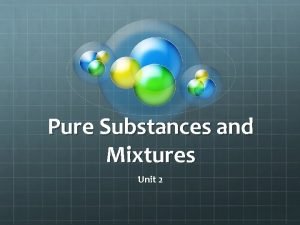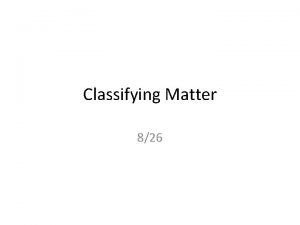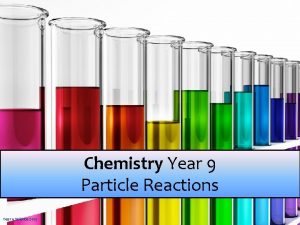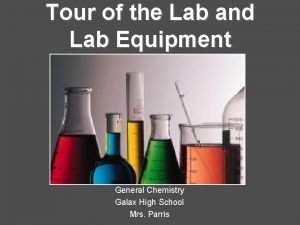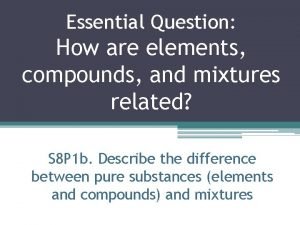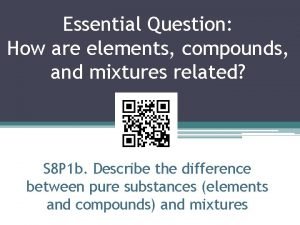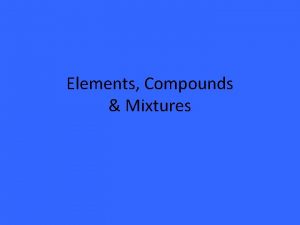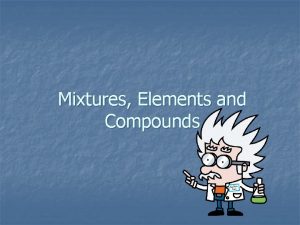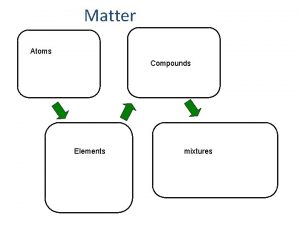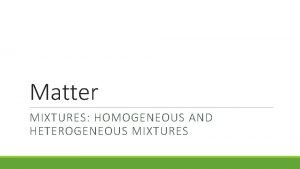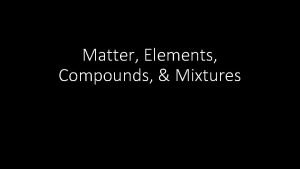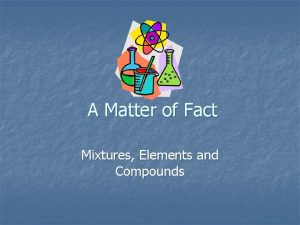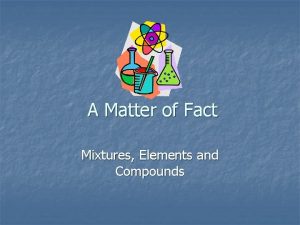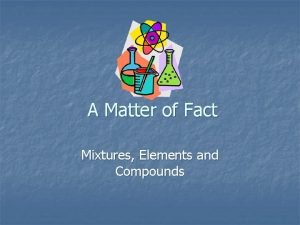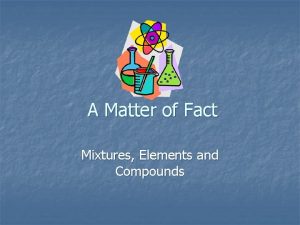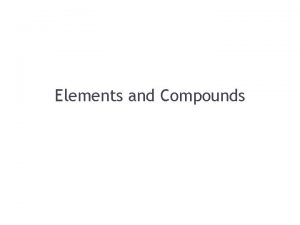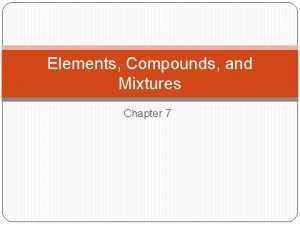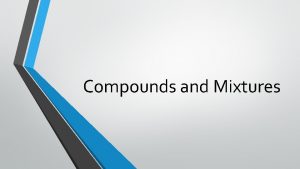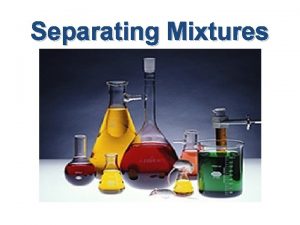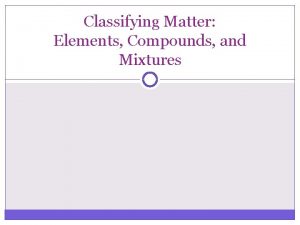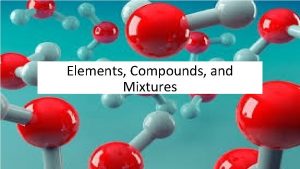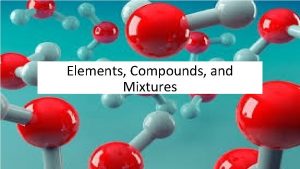A Matter of Fact Mixtures Elements and Compounds


































- Slides: 34

A Matter of Fact Mixtures, Elements and Compounds

Goal: To classify common substances as a mixture, element or compound

Bell Work n Write a property of matter headline for each of the pictures below. A B C

Agenda n n n Bell work Check Homework Review U of T Homework More Notes Work on Packet Homework: Finish Packet

Mixtures, elements, compounds n n n Scientists like to classify things. One way that scientists classify matter is by its composition. Ultimately, all matter can be classified as mixtures, elements or compounds.

Why isn’t it a good idea to classify matter by its phases? n Because one kind of substance can exist in more than one phase – such as H 20. And matter changes phases rather easily.

Why isn’t matter classified according to its physical characteristics, such as color? n Scientists wouldn’t find it very useful to group gold, sunflowers, and the sun together.

n What is matter? n n Anything that has mass and takes up space Scientists ask themselves these questions Is the matter uniform throughout? n Can it be separated by physical means? n Can it be separated by chemical means? n

By asking these questions scientists can classify matter into: n Mixtures – two or more substances that are not chemically combined with each other and can be separated by physical means. The substances in a mixture retain their individual properties. n Solutions – a special kind of mixture where one substance dissolves in another. n Elements – simplest form of pure substance. They cannot be broken into anything else by physical or chemical means. n Compounds – pure substances that are the unions of two or more different elements. They can be broken into simpler substances by chemical means. n A molecule is when two or more atoms (can be the same element i. e. O 2) are chemically joined together.

Elements n Elements are the simplest pure substance. n n The smallest particle of an element that has the properties of that element is called an atom. n n An element can not be changed into a simpler substance by heating or any chemical process. An atom is the basic building block of matter. There are more than one hundred known elements in the universe listed on the periodic table of elements. n These elements combine in such a way to create millions of compounds.

Compounds n n Compounds are also pure substances. But compounds are made from more than one element. Water is a compound. Water can be broken down into simpler substances – hydrogen and oxygen.

Pure vs. Impure n n A pure substance is matter for which a chemical formula can be written. Elements and compounds are pure substances. n i. e. glucose (C 6 H 12 O 6), fluorine An impure substance is a mixture. A mixture contains two or more elements or compounds n i. e. concrete, salt water

Learning Check n Identify the following as a pure substance or a mixture: Chlorine n Water n Soil n Sugar Water n Oxygen n Rocky Road Ice Cream n

Mixtures: Heterogeneous or Homogeneous

Is it uniform throughout? n If the answer is no, the matter is a heterogeneous mixture. Considered the “least mixed. ” n Does not appear to be the same throughout. n Particles are large enough to be seen and to be separated from the mixture. n

Examples of heterogeneous mixtures n n n Sand pebbles Oil and water Powdered iron and powdered sulfur

Granite is a heterogeneous mixture.


Is it uniform throughout? n If the answer is yes, the matter is homogeneous mixture (looks the same throughout).

Homogeneous Mixtures n n n A mixture that appears to be the same throughout. It is “well mixed. ” The particles that make up the mixture are very small and not easily recognizable.

Examples of homogeneous mixtures Homogenized Milk and Toothpaste are homogeneous mixtures.

Learning Check n Identify the following as homogeneous or heterogeneous n n n Concrete Drinking Water Bag of popcorn Trail mix Air

Types of Mixtures

Suspensions n n n Heterogeneous fluid containing large, solid particles Will settle upon standing Ex: Muddy water, oil and vinegar dressing

Colloids n n In a colloid the particles are mixed together but not dissolved. The particles are relatively large and are kept permanently suspended.

Colloids n n A colloid will not separate upon standing. The particles are constantly colliding, and this allows a colloid to scatter light – thus colloids often seem cloudy.



Solutions n n A solution is a type of homogeneous mixture formed when one substance dissolves in another. It is the best mixed of all mixtures. A solution always has a substance that is dissolved and a substance that does the dissolving. The substance that is dissolved is the solute and the substance that does the dissolving is the solvent.

Ocean water is a solution

Water as a solvent n n n Many liquid solutions contain water as the solvent. Ocean water is basically a water solution that contains many salts. Body fluids are also water solutions.

Types of solutions Solute Solvent Example Gas Gas Liquid Solid Liquid Air (oxygen in nitrogen) Soda water (carbon dioxide in water) Ocean water (salt in water) Solid Gold jewelry (copper in gold) Metals dissolved in metals are called alloys.

Air is a solution of oxygen and other gases dissolved in nitrogen

Alloys Stainless steel is a mixture of iron and chromium. Brass is an alloy of copper and zinc.
 Classifying elements compounds and mixtures
Classifying elements compounds and mixtures Is chex mix a heterogeneous mixture
Is chex mix a heterogeneous mixture Elements, compounds and mixtures worksheet with answers
Elements, compounds and mixtures worksheet with answers Periodic table mixtures
Periodic table mixtures Elements compounds and mixtures ks3
Elements compounds and mixtures ks3 Elements and compounds graphic organizer
Elements and compounds graphic organizer Homogeneous mixture
Homogeneous mixture Elements compounds and mixtures oh my worksheet
Elements compounds and mixtures oh my worksheet Elements compounds and mixtures quiz
Elements compounds and mixtures quiz Is lemonade a compound or mixture
Is lemonade a compound or mixture Is sugar a pure substance
Is sugar a pure substance Copper does it have a uniform composition
Copper does it have a uniform composition Compounds vs mixtures
Compounds vs mixtures Machanical mixture
Machanical mixture How can matter be classified
How can matter be classified Ionic vs covalent venn diagram
Ionic vs covalent venn diagram White matter nervous system
White matter nervous system Gyrus and sulcus function
Gyrus and sulcus function Gray matter and white matter
Gray matter and white matter What is gray matter
What is gray matter Honey is homogeneous or heterogeneous
Honey is homogeneous or heterogeneous Mixture of compounds diagram
Mixture of compounds diagram Is a bag of m&ms a mixture or pure substance
Is a bag of m&ms a mixture or pure substance Elements and compounds examples
Elements and compounds examples Section 1 atoms elements and compounds
Section 1 atoms elements and compounds Chapter 6 section 1 atoms elements and compounds
Chapter 6 section 1 atoms elements and compounds Laboratory equipment
Laboratory equipment Study jams elements and compounds
Study jams elements and compounds Elements and compounds study jams
Elements and compounds study jams Chapter 6 section 1 atoms elements and compounds
Chapter 6 section 1 atoms elements and compounds Section 1 composition of matter
Section 1 composition of matter Section 1 composition of matter
Section 1 composition of matter Chapter 2 matter section 1 classifying matter answer key
Chapter 2 matter section 1 classifying matter answer key Section 1 composition of matter
Section 1 composition of matter Ecological succession
Ecological succession
